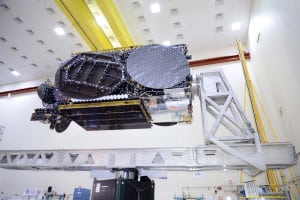Latest News
[Via Satellite 10-29-2015] Canada-based MacDonald Dettwiler and Associates (MDA), owner of U.S. satellite manufacturer Space Systems Loral (SSL), says being located in Canada has provided the company no reprieve from satellite financing challenges related to the closure of Ex-Im Bank. The U.S. Congress let the Ex-Im bank’s charter expire June 30, suspending the Export Credit Agency’s (ECA) ability to take on new projects. The satellite industry grew to become of increasing importance to Ex-Im Bank, and vice versa over the past few years, and U.S. manufacturers have cited the bank’s absence as a reason for losing business.
Canada has it’s own ECA, known as Export Development Canada (EDC), but Daniel Friedman, president and CEO of MDA, said the domestic agency has not filled the void left by Ex-Im.
“Contrary to popular belief in the press, we don’t have an advantage with EDC access. We’ve been hit by Ex-Im probably harder than anybody else,” Friedman said Oct. 28 during the company’s third quarter 2015 earnings call. “They’re our main source of financing satellites, and so we haven’t seen the financing be an advantage for us and we don’t foresee that to be in the next couple of months. There is no advantage there.”
MDA’s most recent commercial satellite award is the Azerspace 2/Intelsat 38 joint satellite, which went to SSL after previously being with Orbital ATK. Earlier this summer, Orbital ATK said the inability to leverage ECA resources caused the order to slip. During an April interview preceding the closure of Ex-Im, EDC told Via Satellite it was seeing an uptick in satellite financing activity. The ECA had recently provided $139 million to fund the Amazonas 5, which SSL is building for Hispasat of Spain.
Recently the U.S House of Representatives voted to reauthorize Ex-Im, leaving the next move up to the Senate. Though there is optimism that Ex-Im is closer to being restored, its absence still weighs on new satellite orders, according to Friedman.
“We are still under the same issue that Ex-Im’s not reauthorized. That has made good progress but still has a way to go. And we still have the issue that SpaceX hasn’t flown,” he said.
SpaceX’s next mission is for Orbcomm to launch the 11 remaining satellites for its second generation (OG2) constellation of Machine-to-Machine (M2M) and Automatic Identification System (AIS) spacecraft. Orbcomm said Oct. 16 that the launch is expected by or around early December. Moog announced earlier this week it had shipped the satellite dispensers for OG2 over to Cape Canaveral, Fla., in preparation for the launch.
Friedman said bidding activity has been high for new satellites to both Geostationary and Low Earth Orbits (GEO and LEO), despite the lack of firm orders. Startups, he said, are active not only in LEO, but also for GEO, but most are in need of financial capital to progress with their plans.
“We continue to see that trend where the more traditional customers are buying a little less and the new emerging customers are buying more. And then no purchases yet, but [there is a lot of] bidding activity relating to people with new ideas about doing new services and approaching things differently, and I don’t just mean LEO, but GEO. But those programs by and large remain unfunded, so I don’t know if they are going to come true,” said Friedman.
He added that MDA is working on proposals for many of these ideas should they come to fruition. Of the GEO communications customers, Friedman said some of the faster movers are sovereign governments. He highlighted Azercosmos as an example.
MDA’s claims to fame in the LEO market are primarily thanks to a contract with Skybox Imaging, now owned by Google, for the production of 13 Earth observation satellites, and a more recent partnership with OneWeb to design payloads for its constellation of several hundred small telecommunications satellites. Friedman said the OneWeb agreement is not a contract, because though a “substantial number of people” at MDA are working on the program, there is currently no fixed-price contract. OneWeb raised $500 million in financing earlier this summer, but Friedman said the startup needs a couple billion dollars more before entering into long-term contracts for production. A joint venture between OneWeb and Airbus is building the spacecraft. Friedman said MDA is trying to help OneWeb obtain financing for the constellation.
Friedman touted SSL’s recent contract award to be the primary industrial partner for a discovery-class NASA exploration mission as evidence of SSL’s strength in the U.S. government market. SSL is designing a composite structure spacecraft bus equipped with a high-power electric propulsion system known as a “power propulsion chassis” for the mission, which aims to research Psyche, a large asteroid comprised of iron and nickel. He added the technology will have good spinoff capabilities for SSL’s commercial business. In the U.S, SSL is involved in certain Defense Advanced Research Projects Agency (DARPA) programs, and also built the propulsion system for NASA’s Lunar Atmosphere Dust Environment Explorer (LADEE) spacecraft. NASA plans to downselect one or two of five discovery missions in late 2016, leading to a launch in the early 2020s.
Friedman said MDA anticipates a few more satellite awards this year overall, and a busy first half of next year. Though admitting this year was atypical in the number of awards, he downplayed concerns about this being a long-term trend.
“Our current forecast is that 2016 will be a normal year,” he said.
Get the latest Via Satellite news!
Subscribe Now